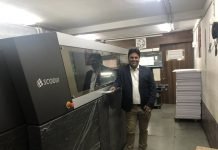Apsom Technologies, a manufacturer of digital printing solutions, has been operational in the printing industry since 1994. Initially, the company provided to the signage industry and was a distributor of signage machines, including DGI from Korea, Roland and Mimaki from Japan, and Flora from China.
The company has offices in Bengaluru, Bhubaneswar, Chennai, and Kolkata with headquarters in Mumbai. Vir Vikram Bhatia, managing director, Apsom Technologies, said, “Till 2011 we were into signage, and after that, we diversified into textile printing industry because the printing process in signage and textile is more or less the same and changes with the substrate. We are also into graphics; 40% of our business is still graphics, and 60% is textile printing.”
The company entered the digital textile printing market with Mimaki machines in 2006, but it was in 2011 when it diversified its business in textiles with full force. “In the beginning stages, we distributed Mimaki machines that ran at the speed of 10 meters per hour; from 2011, we started dealing with Konica Minolta machines with a printing speed of 30-40 meters per hour. Now we have machines printing at a speed of 60 meters per minute. We now deal with high-speed textile printers. Recently, we sold a high-speed single-pass textile printer Konica Minolta Nassenger SP1, to Shree Jee, based in Mumbai, during ITMA Barcelona. The machine will be installed by December 2019,” Bhatia explained.
The company launched two digital textile printing machines during Gartex 2019 for the first time in India – Coltex CD – 1800 direct to fabric printer from China with Konica Minolta printheads and Top Banner TB 2380S direct dye-sublimation printer with Seiko printheads. The 72-inch Coltex printer can print 1000 meters per day and is an entry-level printer for printing on natural fabrics, and the 86 inch Top Banner printer can print directly on polyester. Bhatia explained that there are two methods of printing on polyester – transfer through paper or sublimation and direct printing. The sublimation technique is suited for sharp print results, while direct printing renders deep ink penetration in fabric. However, the polyester needs coating before printing irrespective of the printing technique.
Speaking about the Indian textile printing market, Bhatia said, “The North Indian market favors low-cost machines. Noida Gurgaon, Ludhiana, Amritsar, Banaras are the main pockets for textile printing. However, in terms of printing technology, India is a mixed market. There are processing houses that are investing in digital printing machines providing good opportunities for digital high-speed machine providers such as Konica Minolta, Reggiani, MS, and Epson. At the same time, customers want inks, and 60-70% of them don’t bother about the print quality till the price of inks is low. But I think the demand for digital textile printing will grow; as of now, it is at 3%.”


















